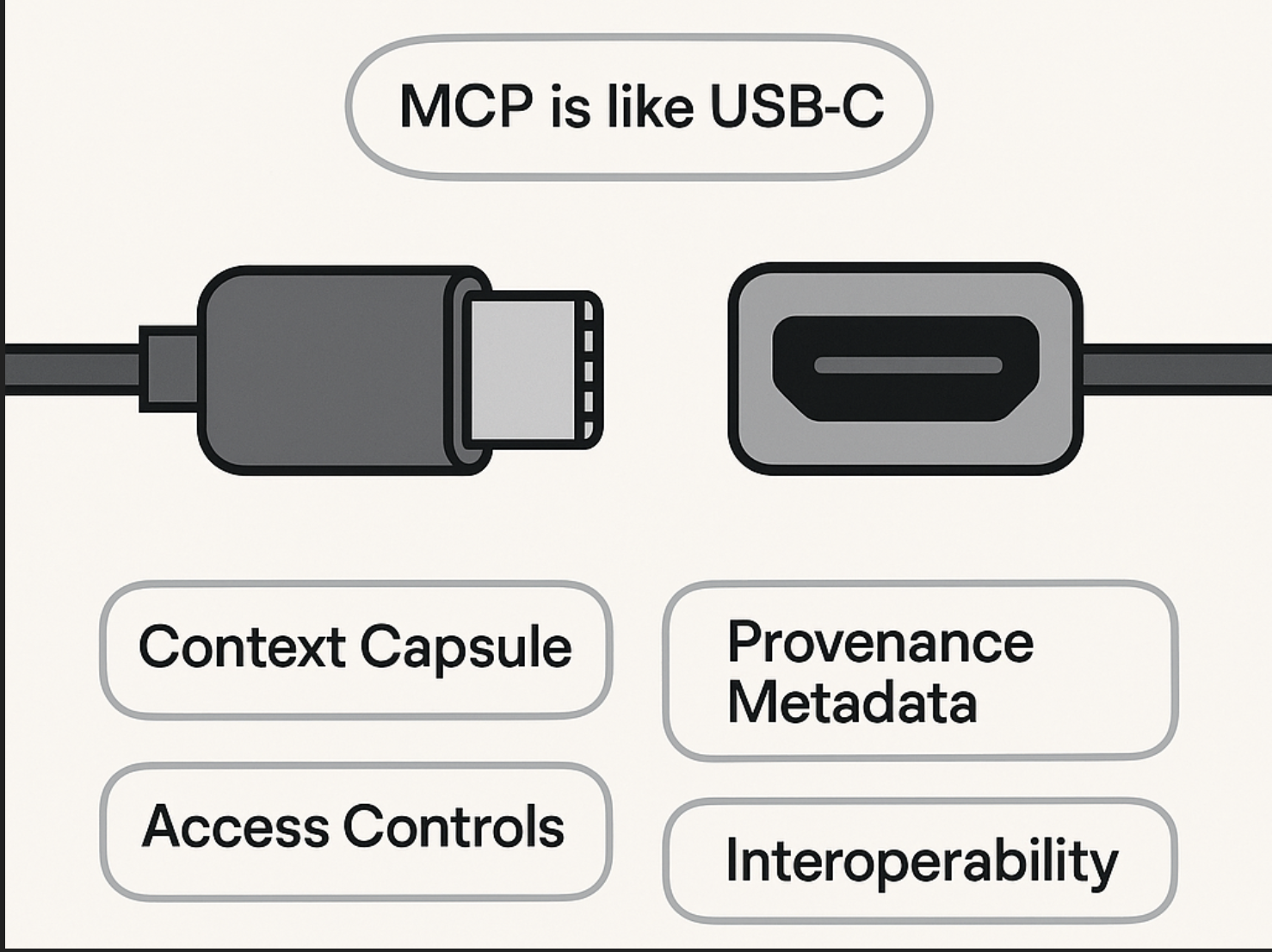As AI evolves from standalone models to complex, multi-agent ecosystems, one thing becomes painfully clear:
Context is everything.
But today, how context flows across AI systems is broken, insecure, and ad-hoc.
We need a universal connector—
That’s what Model Context Protocol (MCP) is.
What is MCP?
MCP is a protocol for safely, modularly, and consistently passing context between AI models.
📦 It defines:
- Context Capsules → structured user/environment/task metadata
- Provenance Metadata → where did the context come from, and who signed it?
- Access Controls → who can see what and when
- Interoperability Layer → standard schema for model-to-model context sharing
Why MCP is like USB-C
Just like USB-C solved device fragmentation and standardized power/data delivery…
MCP standardizes how AI models talk to each other.
Whether you’re using OpenAI for summarization, Anthropic for safety review, or Perplexity for search—
MCP enables seamless and secure context handoff across the stack.
What It Enables
✅ Safer, trust-aware AI systems
✅ Personalised copilots that follow you across apps
✅ Modular chains of models that share one unified context
✅ Auditable, privacy-respecting information flows
The Future of Context-Aware AI
With MCP, context is no longer a local input—
It becomes a first-class citizen across your AI architecture.
Whether you’re building retrieval pipelines, agentic systems, or enterprise copilots, MCP unlocks the next level of capability and control.
How MCP Enablement Works Inside an Organization
Enabling Model Context Protocol in your organization isn’t just about adopting a spec—it’s about rethinking how models interoperate with users, applications, and each other in a consistent, trusted way.
Here’s what it looks like in practice:
MCP Enablement Layers
| Layer | Description |
|---|---|
| 1. Context Authoring | Apps generate structured Context Capsules—task descriptions, user state, environment signals. |
| 2. Signing & Provenance | Capsules are signed by trusted sources (e.g., your CRM, calendar, or data warehouse). |
| 3. Transport & Exchange | Capsules move between services/models via APIs or shared memory. |
| 4. Model Runtime Ingestion | Models decode, validate, and act on context in a principled way. |
MCP Clients vs MCP Servers
As organizations implement MCP, they typically deploy two key roles in their architecture:
🖥️ MCP Client
An MCP Client is any application, service, or orchestration layer that:
- Creates, packages, and transmits a
Context Capsule - Signs it with trusted metadata
- Forwards it to a downstream model or system via MCP
🔧 Examples:
- An internal user dashboard passing session metadata to a summarization model
- A workflow agent crafting a task capsule for downstream model execution
🗃️ MCP Server
An MCP Server is any AI model or service endpoint that:
- Receives, unpacks, and validates the MCP context
- Enforces trust rules (e.g., does it trust the context signer?)
- Uses the capsule to guide generation or processing
🔧 Examples:
- An OpenAI-powered LLM using a signed capsule to safely interpret a user’s goal
- A retrieval service checking context scope before answering a query
Together, MCP Clients and Servers form the backbone of safe, composable AI infrastructure—powering everything from cross-tool copilots to multi-model orchestration chains.
Where MCP Standards Live
MCP isn’t (yet) governed by a formal standards body—but OpenAI, Anthropic, Meta, and others are converging on early practices. These can be found or tracked through:
- 📚 OpenAI Dev Docs — platform.openai.com/docs
- 🧠 OpenAgents GitHub — initiatives that model open agent protocols using MCP-like structure
- 🔓 AI Engineer Foundation — standards emerging around AI orchestration and trusted context
- 📄 Draft RFCs (expected): community-led documentation of standard schema and interfaces
Final Thought
MCP is the missing piece for trustworthy, modular, enterprise-ready AI.
It’s not just a protocol—it’s a mindset.
If you’re deploying AI in real-world systems, it’s time to treat context like infrastructure.

